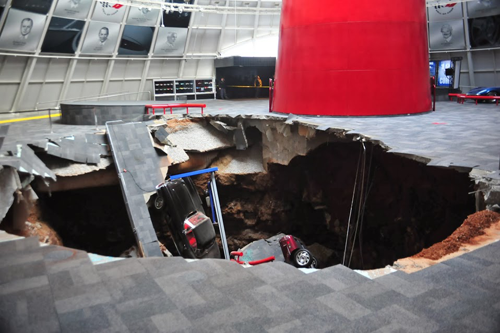Sinkhole Science: Sudden Hole Swallows Corvettes Whole
A car museum turned into a tragic no parking zone this week when a sinkhole opened up, wiping out a fleet of prized automobiles. Sinkholes apparently have no regard for the caliber of car or building that may be sitting on the surface, but what happens below the surface to account for sudden and catastrophic openings? With hands-on science projects sponsored by Chevron, students can experiment to learn more.

If you are a car aficionado, headline news today about the fate of eight cars in the National Corvette Museum in KY might make you cringe. A sinkhole appeared in part of the museum, reportedly swallowing a set of corvettes whole. Among the cars lost when the floor disappeared: a 1993 ZR-1 Spyder and a 1962 Black Corvette.
Whether you mourn the loss of the cars or not, sinkholes are scary. They are scary because they seemingly appear out of nowhere. The sinkhole that created an instant no-parking area at the museum is reportedly 40 feet wide and approximately 25 to 30 feet deep. What causes a section of ground cavernous enough to simply eat whatever was sitting on top of it to suddenly open up?
Sinkhole Geology
Sinkholes can be triggered by a number of different geologic processes, movements and reactions that are often unpredictable, unavoidable, invisible, and disastrous. In some cases, the reactions take years of time; in other cases, extreme conditions can create rapid change. As this video explains, earthquakes can trigger seemingly instantaneous sinkholes by causing temporary liquefaction of water-logged loose soil.
Liquefaction is one way a sinkhole may form, but other geologic processes contribute to and are responsible for sinkhole phenomena.
In the case of the missing corvettes, limestone may have something to do with what happened to the ground floor of the museum.
The Power of Water
Over time, the pH of water that runs over rocks can destabilize the structure of an area. We know that rocks are gradually eroded by many natural processes, but under certain conditions—and in the presence of specific kinds of liquids—some rocks actually dissolve and, ultimately, disappear. It may seem hard to believe that rocks that are big and hard can be conquered by simple, flowing liquids, but in the case of certain sedimentary rocks, that is exactly what happens.
Over time, or in the case of prolonged or extreme precipitation and flooding, water can build up in soil systems. In other cases, rocks are located in a place that receives frequent or periodic water. If the water is acidic, it may begin to destabilize the structure of rocks that contain carbonate compounds, rocks like limestone. The dissolution of rocks due to the pH of water can cause changes in the topography of an area, including sinkholes. (These changes are referred to as karst topography.)
Sinkholes may take years to silently form, or, they may appear suddenly, swallowing buildings, houses, trees—or even corvettes.
Note: Sinkholes propelled by pressure and resulting liquefaction may solidify again, cementing structures in the ground where they've been half-swallowed. Sinkholes created by erosion or dissolution of rock, on the other hand, won't suddenly seal back up as if the hole never happened. The hole becomes a new part of the topography of the landscape.
Making Connections
The corvette museum in Bowling Green, KY, is about thirty miles from the opening of Mammoth Cave, a system of more than 300 miles of mapped underground cave passages—caves full of limestone. The area surrounding Mammoth Cave is littered with visible sinkhole depressions and is referred to as the sinkhole plain.
Students curious about sinkholes can experiment on a small-scale basis using the Now You See It, Now You Don't! How Acidic Waters Make Rocks Disappear Project Idea. In the project, students learn more about the ways in which acidic water conditions may appear and conduct a hands-on test to observe the impact of vinegar on limestone over time.
Students can explore related science in the Factors that Affect the Transfer of Force through Saturated Soil project.
Support for Geology resources and Project Ideas at Science Buddies is provided by Chevron.
Categories:
You Might Also Enjoy These Related Posts:
- Plastics and Earth Day - Science Projects
- Arduino Science Projects and Physical Computing
- 10+ Robotics Projects with the BlueBot Kit
- 5 STEM Activities with Marshmallow Peeps
- March Madness Basketball Science Projects: Sports Science Experiments
- Women in STEM! More than 60 Scientists and Engineers for Women's History Month
- Explore Artificial Intelligence and Machine Learning with Student AI Projects
- 10 Reasons to Do the Rubber Band Car Engineering Challenge









